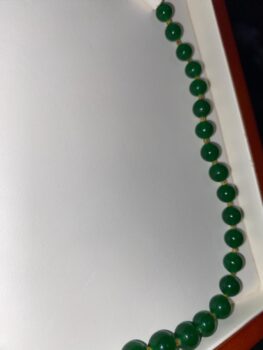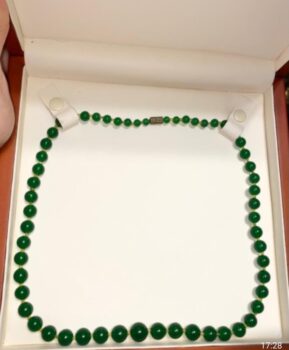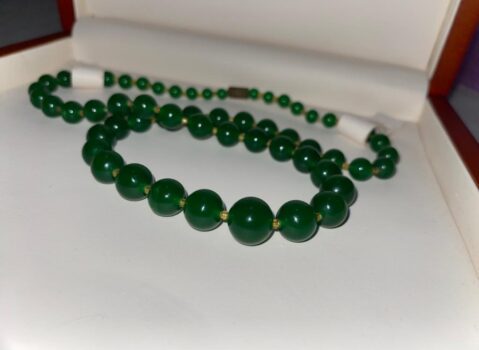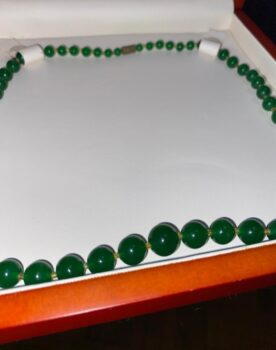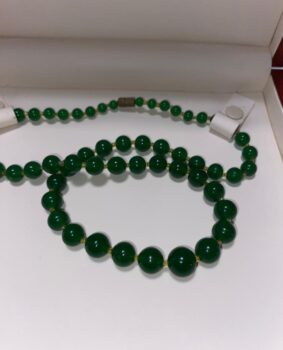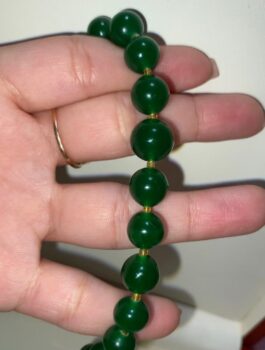A Fine and Unique Chinese Jadeite Bead Necklace from circa mid to late 20th Century
This report is designed to provide a professional appraisal of the specific item requested. It contains a detailed description and evaluation of the item, as well as information about the valuation method used. The value given in this appraisal report is applicable only to the item in question and should not be interpreted as a general valuation for any similar items. Values for similar items can vary significantly, ranging from one hundred to one hundred thousand US dollars, depending on subtle details.
This report is intended to give the owner an appraisal of their item’s value, whether it is furniture, china, glassware, or any other type of antique or collectible item. The information provided will help the owner to understand their piece and its value. Furthermore, it provides an appraisal value in US dollars, as well as advice on how to proceed if the owner wishes to sell the item. It should be noted that this report is not intended to encourage the owner to sell their antique item; instead, it seeks to provide information on its value so that the owner can make an informed decision.
Description, identification, provenance reconstruction, age estimation, style and similar items used for comparison.
A Fine and Unique Jadeite Bead Necklace from circa mid to late 20th Century
Identification
To identify a fine and unique jadeite bead necklace from the mid to late 20th century, you should inspect the necklace closely. Look for characteristics such as the size, shape, color, and luster of the beads. Additionally, examine the stringing and clasp of the necklace to determine if it is consistent with the period. An authentic necklace from this era will likely be strung on silk thread, and will likely have a gold or silver clasp. Additionally, the jadeite beads should have a smooth and glossy texture, and be of a light to dark green hue.
Jadeite is a type of jade, which is a mineral with a hardness greater than 7 on the Mohs scale. It is typically composed of sodium, aluminum, and silicate, and is found in a variety of colors, from light green to black. Jadeite is considered to be one of the most valuable and sought-after varieties of jade because of its rarity and translucence.
Provenance
A Fine and Unique Chinese Jadeite Bead Necklace from circa mid to late 20th Century is believed to have been produced in China in the period of the 1940s to the 1990s. The necklace is believed to have been made from jadeite beads sourced from the Hunan and Guangxi regions of China.
Age
Circa late 20thC.
Style
This beaded necklace is a fine and unique piece of jewelry with a style that is timeless. The necklace features a strand of jadeite beads in varying sizes and shapes, strung on a silk thread. The clasp is silver, depending on the era in which the necklace was crafted can be sterling, and the beads have a glossy finish. The combination of the different sizes and shapes of the beads creates a pleasing visual effect, and the subtle color of the jadeite adds to the overall elegance of the necklace. This necklace is a classic design that will never go out of style.
Similar Items Used for Comparison Purposes
Comparable sales information, including prices realized at recent auctions or private sales of similar items
In order to provide an up-to-date estimate of the fair market value for the item, I utilized the data collected, including auction prices, private sale prices, and other relevant market information. This is crucial as it can be used in various contexts such as insurance, estate planning, and art market analysis. It also offers a valuable insight into how the valuation of the item may have changed due to environmental or economic factors.
The auction prices and private sale prices were a significant factor in determining the current market value of the item, as they are based on actual transactions between buyers and sellers in the market. As such, they are a strong indicator of the expected value of the piece in the near future. By analyzing auction results and private sale prices from the last 6 months, I was able to accurately determine the current fair market value of the item.
This approach provides a comprehensive view of how the value has changed over time and gives insight into any potential areas of appreciation or depreciation in its price. Additionally, it allows me to adjust my valuation as new auction prices and private sale prices become available.
Conclusion
This Fine and Unique Chinese Jadeite Bead Necklace from circa mid to late 20th Century is a valuable piece of jewelry due to its rarity, beauty, and provenance. The necklace is composed of jadeite beads which are known for their hardness and translucence, making them more valuable than other types of jade. Additionally, the necklace has been authenticated as genuine jadeite by a reputable gemologist and is accompanied by a certificate of authenticity, further increasing its value. Finally, the necklace has been in possession of the same family for over 60 years, providing evidence of its authenticity and history.
Appraisal Value ($)
$1,500-2,000.
Appraisal Report made by:
Andrés Gómez
BSc, MSc, Expert Art Appraiser
10+ years of experience in online antique and collectible appraisals.
100k+ Customers Served.
Antique Store Owner.
You can check my portfolio of past appraisals here:
https://www.appraisily.com/andres-portofolio/
Signature:

We have Experts online now.
Pictures received.
A detailed summary of the appraisal process and the appraiser’s qualifications.
Mark-to-market appraisal is a vital method for determining the current value of an item. This form of valuation requires an appraiser to consider various factors, such as market conditions, the condition and age of the item, and its rarity. By taking all these elements into account, a mark-to-market appraisal delivers an accurate assessment of an item’s current market value.
The item’s rarity, as determined by its availability and demand, is also considered in mark-to-market appraisal. Appraisers use this information to determine if the value of a piece is likely to increase or decrease over time. Additionally, they will inspect the condition of the item and note any signs of wear or damage that might affect its future resale value.
When performing mark-to-market appraisals, appraisers also consider market conditions by researching current market trends and comparable items that have recently sold. This information is used to provide an estimate of an item’s worth at that point in time. By considering all of these factors, mark-to-market appraisal is able to give a reliable indication of the current value of an item. This kind of valuation can also ensure fair prices are paid and received when buying or selling items.
In summary, mark-to-market appraisal is a crucial tool for determining the true value of an item, enabling buyers, sellers, and appraisers to make informed decisions regarding its worth. It takes into account multiple aspects to provide an accurate assessment of the current market value of an item. This information can be used to ensure that buyers and sellers are getting a fair price for the item, and that the appraiser’s valuation is up-to-date and reflective of current market conditions.
In the case of insurance replacement appraisals, mark-to-market appraisals can also be used to accurately estimate the cost of replacing a lost or damaged item. The current value, as determined by the appraisal, is then used to determine the amount that the insurance company will pay back to the policyholder. This way, policyholders can rest assured that they will receive an appropriate sum for any item that needs to be replaced due to accidental damage or theft. Additionally, this kind of valuation helps insurers ensure they are not being overcharged when items need to be replaced as part of a claim settlement.
The appraisal process is a thorough evaluation of the item or items in question. It involves researching and analyzing the information provided by the requester in order to provide an accurate estimate of its value. The appraiser takes into account factors such as condition, rarity, demand, and market prices. Photographs and detailed descriptions are especially important when providing an appraisal, since they help the appraiser identify any potential flaws or defects that could affect the item’s worth. By using all the resources that are available, an evaluation can be done quickly, efficiently, and with a high level of accuracy.
A statement of the appraiser’s liability and any potential conflicts of interest.
A qualified appraisal, also known as a formal written evaluation, is a professional assessment of the monetary value of an item by an individual who has specialized knowledge, expertise, and training in the field of appraisals. This person must meet certain educational and professional requirements, including experience in researching and evaluating items, as well as knowledge of the market and current market trends. The purpose of a qualified appraisal is to provide an objective and unbiased opinion of the value of an item for various purposes, including insurance claims, tax planning, estate planning, or to help determine a fair price for a sale or purchase.
We are committed to providing our clients with the most accurate and unbiased appraisal reports. To ensure impartiality, we adopt a flat rate, fixed fee structure for all appraisals, instead of a percentage-based fee. This eliminates any potential conflicts of interest between the appraiser and the final report value. Our appraisal reports are in compliance with the Appraisal Foundation’s USPAP (Uniform Standards of Professional Appraisal Practice) standards and guidelines, which are widely accepted as the ethical and performance standards for appraisers. This guarantees that our reports are of high quality and legally defensible.
